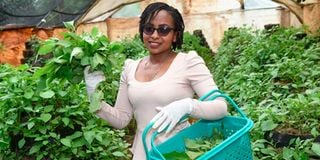How we can feed more people without increasing production

Ms Mutile Wambua, 34, harvests nightshade vegetables (managu) at her farm in Yamumbi, Uasin Gishu County.
What you need to know:
- The challenge of ensuring food and nutrition security is one that global economies share.
- In Kenya, we lose and waste between 30 and 40 per cent of the food we produce.
Food waste and food losses remain a major challenge globally, not just for poor consumers, but for policy makers and government leaders alike. Over the years, the focus on attaining food and nutrition security has been through increased agricultural production, with approximately 95 per cent of investment in the agriculture sector being allocated towards improving and increasing production.
However, due to complex factors – like urban poverty and high post-harvest losses – increased yields have not translated to a direct impact on food and nutrition security. Ironically, food losses and wastage only receive less than five percent of research funding.
The challenge of ensuring food and nutrition security is one that global economies share. The UN Sustainable Development Goals (SDGs) highlight this under SDG 2 on zero hunger. Globally, food wastage and losses are approximated at 1.3 billion tonnes annually. Developed countries record higher levels of waste and losses at 670 million tonnes compared to developed countries at 630 million tonnes.
The food thus wasted and lost is enough to feed two billion people – about a quarter of the global population. By contrast, only 811 million people experience hunger globally, meaning that reducing food waste and losses is sufficient to address the imbalance in food security and to feed the most vulnerable populations.
High levels of food waste and losses are a direct setback to all efforts geared towards ensuring food and nutrition security. Incidentally, the food being produced currently is enough to meet humanity’s collective food demands – but only if it is better managed.
According to the Food and Agriculture Organisation (FAO), food loss occurs when food leaves the food chain at production and post-harvest stages, while food waste occurs at the retail and consumption stages.
Food waste and losses, therefore, are a symptom of inefficiencies within the food system. With significant investment going into improving productivity, more investment is needed post-production to ensure that improved productivity translates to improved food and nutrition security.
Challenge of food waste
Post-production investment is critical as most losses and waste occurs once the harvests leave the farm. In Sub-Saharan Africa, for instance, 70 per cent of food waste and losses is in the post-production and post-harvest handling of food.
Another 12 per cent is lost in processing, 10 per cent in distribution and eight per cent at the consumption stage. These figures should give an indication into the areas where more investment is needed to reduce waste and losses because data ought to influence decision-making.
In Kenya, we lose and waste between 30 and 40 per cent of the food we produce. According to a FAO report, post-production losses account for 60 percent of the food lost. This can be mainly attributed to poor post-harvest management mechanisms – such as weak market linkages, poor handling and storage of food as well as limited value addition and processing capacity.
The losses are particularly predominant during seasons of bumper harvest, especially when farmers who practice irrigation happen to harvest at the same time as those who rely on rain-fed agriculture. This situation keeps the country in a loop of abundance and scarcity of food with every product cycle.
It is important to address this challenge of food waste and losses because it has social, environmental and economic implications. Socially, food waste losses lead to increased poverty arising from lost incomes and extended food and nutrition security. Environmentally, food waste contributes to greenhouse gas emissions as it releases methane while decomposing.
Economically, food waste and losses are a double tragedy because investments are wasted even as returns on investment are forgone. This is part of the reason why Kenyan farmers – and by extension rural communities In Kenya remain poor. On average, approximately Sh72 billion is lost every year, according to a recent report by FAO. This is money lost in investments channeled to producing the food as well as forgone returns.
If we are to realise the true potential of the investments made in the agriculture sector and achieve the goal of zero hunger, we need to better manage the food we already have even as we seek to enhance productivity. Increasing yields of, and by itself, will not get us to the promised land of food and nutrition security.
Ms Yegon is a food specialist with FAO and Fellow at African Food Fellowship. [email protected]





